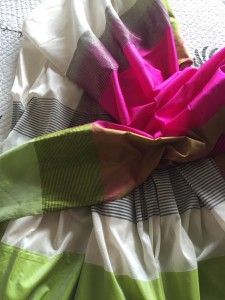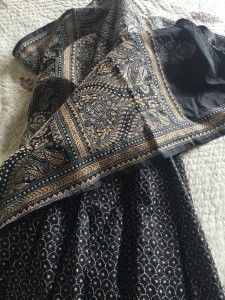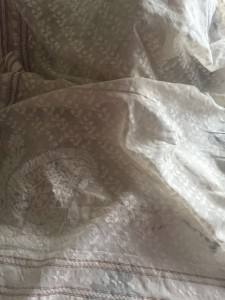A black and white Phad painting, made by Paramparik Karigar craft member Kalyan Joshi from Bhilwara has been selected to be put up at the Prime minister Shri Narendra Modi’s residence at 7, Racecourse Road.
A black and white Phad painting, made by Paramparik Karigar craft member Kalyan Joshi from Bhilwara has been selected to be put up at the Prime minister Shri Narendra Modi’s residence at 7, Racecourse Road.
Download to read the latest update across our Bulletin page: There’s renewed interest in handlooms: Click here to download the PDF and read
Few other latest updates:
To know about our upcoming exhibitions, workshops, events, media updates feel free to reach us here:
Paramparik Karigar exhibition in Mumbai on August 19,20,21,22, at WTC
Tribal Weave by Kapilo Mohonto at Paramparik Karigar exhibition August 19,20,21,22, at WTC
Sanganeri prints by Dhanopia at the Paramparik Karigar exhibition at WTC on 19,20,21,22 August.
Maheshwari Saree by Akhil Ansari & Ganesh Bicchawe at Paramparik Karigar exhibition August 19,20,21,22, at WTC

Maheshwari Saree by Akhil Ansari & Ganesh Bicchawe at Paramparik Karigar exhibition August 19,20,21,22, at WTC
Kantha Saree and Yardage by Alima & Takdira at Paramparik Karigar exhibition August 19,20,21,22, at WTC

Kantha Saree and Yardage by Alima & Takdira at Paramparik Karigar exhibition August 19,20,21,22, at WTC
Diaphanous Muslin Jamdani Saree by Jyotish Debnath at Paramparik Karigar exhibition August 19,20,21,22, at WTC.

Diaphanous Muslin Jamdani Saree by Jyotish Debnath at Paramparik Karigar exhibition August 19,20,21,22, at WTC.
Ashavali Saree for the first time at the Paramparik Karigar exhibition August 19,20,21,22, at WTC
LATEST NEWS and Event Updates:
Invitation Card – August 2016 Mumbai Exhibition from Paramparik Karigar
Exhibition and Sale: Traditional arts, crafts and textile exhibition in Mumbai (click on image below to enlarge)
WEBSITE link: http://paramparikkarigar.ngo/exhibitions.html
Join us on Facebook – Paramparik Karigar
Related post:
Art & Craft Workshops from Paramparik Karigar
Art & Craft Workshops from Paramparik Karigar
Read Finding My Way—explore the world through the eyes of Venkat Raman Singh Shyam Gond artist Madhya Pradesh
Click on the link above to know more about this book.
Interview with Gurrupa Chetty and Niranjan Chetty on Kalamkari an art form from Andhra Pradesh
On Kalamkari: In Conversation with Jonnalagadda Gurappa Chetty
We had the opportunity to speak to Jonnalagadda Gurappa Chetty who is a renowned kalamkari artist based in Srikalahasti, Andhra Pradesh. He provides insight into the history and current practice of kalamkari in India.
– Srikalahasti, June 2015
Gurappa begins by telling us that he learnt the craft of kalamkari from his father. He also acknowledges that this craft was developed with the help of Kamaladevi Chattopadhyay— she was a true pioneer and through her efforts, many of India’s crafts were revived and reinvigorated. Many of our music academies, craft centres and craft councils today were initially set up by her. Gurappa informs us that craft-making in our country was generally community specific and knowledge was passed on from one generation to the next. No institutions or colleges for teaching crafts were deemed necessary. For example, he explains that a potter was helped by his entire family—the children would help in carrying pots and everyone including the wife would help in making the pots. The Government’s system of craft education is different from this and the All India Handicrafts Board started the first training centre for kalamkari.Gurappa, who was a trained school teacher, was amongst the first few trainees there.
Gurappa further goes on to explain that while the craft is known as kalamkari today, this was not its original name (it was called ‘vrathapani’). The textile craft at Machilipatnam, in Bandar, is also called kalamkari but there they carve designs on blocks of wood and the cloth is printed. In Telugu this is called ‘ardhakam’, which means printing. So he feels that, considering the technical differences, one cannot refer to both the crafts as kalamkari!
Earlier, craft was patronized by the royal families and the temples of a region. This was how crafts were able to develop at the time. For various reasons, the crafts declined until they were revived with the help of Ms. Chattopadhyay. Today, the artists continue to depict epics such as the Ramayana, Mahabharatam, and tales from the Bhagavatam etc. In Srikalahasti there is the Dharmaraja temple and also another one dedicated to Shiva. Similarly, Gurappa says that there are around 220 other temples in his district. Craftspersons have traditionally been making panels with the Mahabharatam story for these temples.
Gurappa explains that there is also science involved in the craft. The artists draw with ink which has been prepared with molasses, rusted iron filings and water. The cloth for kalamkari is prepared with ‘kadka’, a combination of myrobalan and milk, and only cloth soaked with this liquid will produce the black colour as the tannin content reacts with the iron acetate. If you apply the ink on ordinary cloth, it won’t produce black.
In rendering the figures, certain conventions are followed. For example, (reciting from the Telugu Bhagavatam by Potana), ‘Krishna nallani vaadu padmanayanambulavaadu, kriparasambupai jalledu vaadu, mauliparisarpita pinchamu vaadu, navvu ra jilledu momu’: Krishna will be rendered in blue. Saraswati will be white, ‘as jasmine, the moon or snow’ (from the Saraswati stotram, ‘Ya kundendu tushara hara dhavala’).
Giving the example of Alimedu, where the stone-carving style is different from that in his area but the figures and themes remain the same, Gurappa says the most important element is the story. In other painting styles also there is a similar commonality of themes rendered in different styles. In Gujarat they make a type of hanging called ‘mata-ni-pachedi’, where they paint figures of Goddess Durga. Similarly, in Orissa, there are the ‘patachitra’ paintings which depict themes like the Krishna Leela.
As kalamkari was a hereditary craft tradition, Gurappa says that he learnt from his father who in turn had learnt from his own father. It was the same in the case of his son J. Niranjan, who is also a renowned kalamkari artist. Niranjan began designing kalamkaris from the time he was a young child. When he was in the fourth standard, he drew a ‘tree of life.’ Gurappa still has that piece with him. In the beginning though, Gurappa says that his son was interested in pursuing medicine until one of the family’s well-wishers asked him, ‘How many doctors in your country and how many engineers in your country?’ and then asked him to compare that to the number of artists who made kalamkari. At that time there were only 50. This conversation made Niranjan realise that instead of choosing a profession already being practised by thousands of people he could be part of something unique.
Gurappa received a National Award from the Government in 1976. At that time they were to start a training programme. One gentlemen called Alu agreed to be a part of this but stated that he would only like to train women because he felt men were only interested in writing, preparing bundles and carrying them! Gurappa agreed to this condition and they started the first training programme for women. Today, many women are learning this craft and Gurappa feels that its popularity can be attributed to the fact that these women can work from home.
Gurappa has travelled extensively. He has also seen his grandfather’s work which is now in England. Similarly he has also been to Sydney. Recently, he was in Ottawa where also he saw a kalamkari. The craft, according to Gurappa, is now world famous! He summarizes our discussion by explaining that kalamkari or vrathapani is the name of their style and in essence it is a craft that involves writing with a brush. The figures that they render follow well-established canons— Rama will have a bow and arrow, Krishna will have a flute, Ravana will be ten-headed, Hanuman will be holding a gada (mace)…
Please see here the link to the interview with Shri Gurappa Chetty on Sahapedia
Upcoming Workshop – Innovation Festival – Art and Crafts Workshop
Photographs of December 2015 Master Craftsmen exhibition
Let’s Connect on Our Facebook page of Paramparik Karigar – Click here
Visit us on our website: www.paramparikkarigar.ngo
Invite for Exhibition and Workshop in January 2016
INVITE for our Upcoming EXHIBITION and WORKSHOP —> http://paramparikkarigar.ngo/exhibitions.html
 follow:
follow: